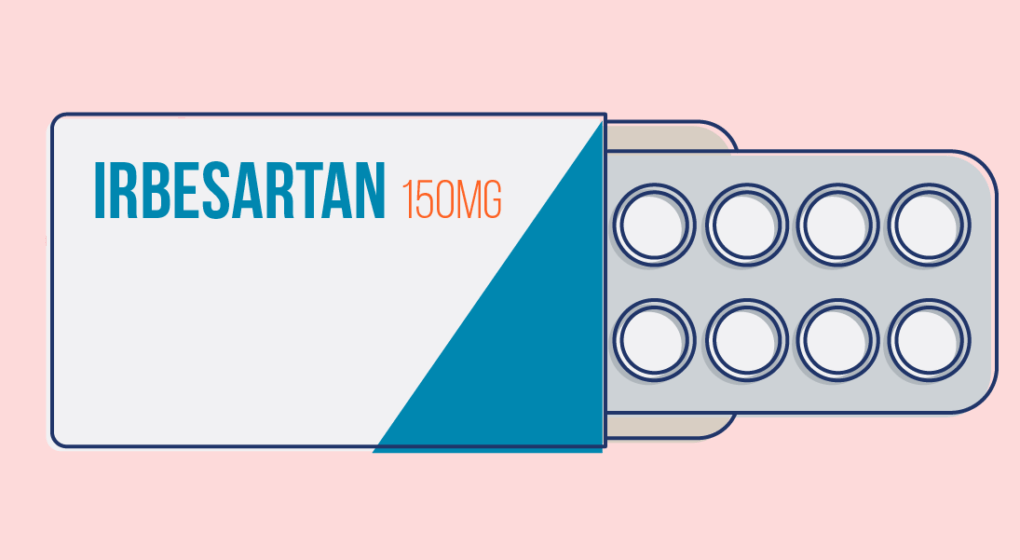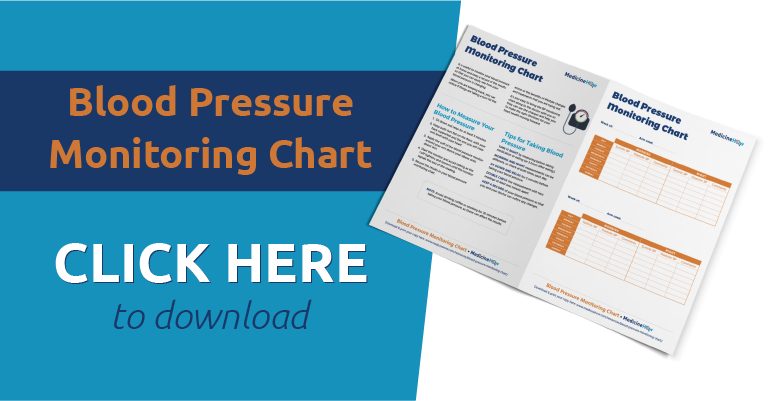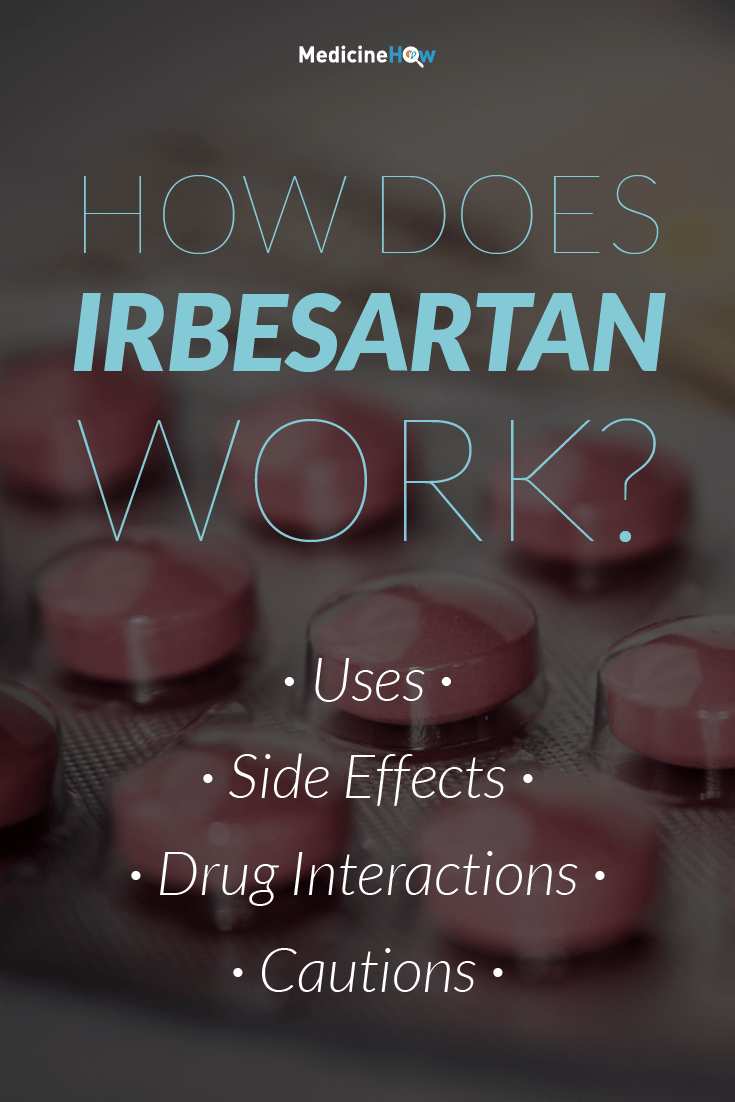
Irbesartan works by stopping a hormone called angiotensin II from activating a receptor in the body that normally leads to a slight increase in blood pressure. When you take a sartan drug like irbesartan, the hormone can’t work as well as usual and, as a result, your blood pressure gets lower. This is useful in the treatment hypertension and prevention of worsening from renal disease.
Brand Names and Doses
![]() Irbesartan is the genic name, the name of the active drug found in the medication. There are two different brand names that contain this medication, which are:
Irbesartan is the genic name, the name of the active drug found in the medication. There are two different brand names that contain this medication, which are:
- Avapro
- Karvea
Both of these contain the same active drug and work in the same way; they’re just made by different companies so have diferent names for marketing. They are both available in three different doses: 75 mg, 150 mg and 300 mg. Most people begin with a low dose of 75 mg to reduce the risk of side effects as your body gets used to the new medication. You can then gradually increase the dose as needed to manage your blood pressure.
Irbesartan is also available in combination with another drug, hydrochlorothiazide. The brand names for the combination medications are Avapro HC and Karvezide. Both of these are available in three different doses:
- 150 mg irbesartan / 12.5 mg hydrochlorothiazide
- 300 mg irbesartan / 12.5 mg hydrochlorothiazide
- 300 mg irbesartan / 25 mg hydrochlorothiazide

What type of drug is it?
![]() Irbesartan is a type of drug called a sartan, which is a group of drugs that work in a similar way. This class is also sometimes known as angiotensin receptor blockers (ARB) or angiotensin receptor antagonists (ARA). Other medicines in the same class are:
Irbesartan is a type of drug called a sartan, which is a group of drugs that work in a similar way. This class is also sometimes known as angiotensin receptor blockers (ARB) or angiotensin receptor antagonists (ARA). Other medicines in the same class are:
How does it work?
![]() Irbesartan works by blocking the angiotensin II hormone from binding to a receptor, which leads to certain changes in that body that usually increase the blood pressure.
Irbesartan works by blocking the angiotensin II hormone from binding to a receptor, which leads to certain changes in that body that usually increase the blood pressure.
In a healthy person, angiotensin II helps to keep the balance of blood pressure in a healthy range. If the blood pressure gets too low, the body produces more angiotensin II to increase its effects and help to increase the blood pressure slightly. It does this by causing the muscles around the blood vessels to contract, making the passageway narrower, and the kidneys to reabsorb more water, increasing the amount of blood in the body. With more blood travelling through narrower vessels, the blood pressure is going to increase.
When you take irbesartan, angiotensin II can’t activate the receptor as well as usual. As a result, the opposite effects happen:
- The muscles around your blood vessels relax, creating more space for the blood passing through.
- There is less blood in your body because your kidneys reabsorb less water and you excrete more in your urine.
Less blood pumping around blood vessels that are larger than usual means the pressure will be lower. If you think of it like a plumbing system, your cardiovascular system will be under less stress, which is a great help for your heart.
Irbesartan is also sometimes used to decrease the risk of renal disease if you are at risk. People with type 2 diabetes mellitus, hypertension and higher levels of protein in their urine are more likely to have problems with their renal system. Irbesartan can help to reduce the risk that you will experience problems.
Side Effects
![]() Because of the way sartans affect the body, there are several side effects that may occur when you take irbesartan.
Because of the way sartans affect the body, there are several side effects that may occur when you take irbesartan.
Low blood pressure (hypotension)
The most common side effects happen when irbesartan is working too well and you end up with low blood pressure. You might notice:
- Headache
- Tiredness
- Dizziness
- Flushing
This is common when you first start taking irbesartan or when you increase the dose. It usually gets better after a few days as your body gets used to the medication. If you still notice the effects after a week, the dose may be too high for you and your blood pressure too low as a result. You can check your blood pressure to find out at a pharmacy and ask your doctor about if you need to reduce the dose.
Excess Potassium (Hyperkalaemia)
Irbesartan works by causing more water to be excreted in the urine than usual, which can upset the concentration of potassium in your body. Less potassium is excreted and it can build up and making you feel tired and you may have muscle weakness
If you have symptoms of hyperkalemia, you can ask your doctor for a blood test to check if you have high potassium levels to decide if you should make a change to your medications.
Cough
Rarely, some people also get a dry cough when they take irbesartan. If this affects you and it is annoying, you can talk to your doctor about alternative medication options for hypertension.
Cautions
![]() There are a couple of things you should be aware of before you start taking irbesartan, which are listed below:
There are a couple of things you should be aware of before you start taking irbesartan, which are listed below:
Angioedema – Dwelling of your mouth and face, which can be dangerous if the airways become blocked. If this occurs, you should see a doctor as soon as possible.
Renal Impairment – Irbesartan changes the function of the kidney and can increase the risk of renal impairment, particularly when used with other medications such as NSAIDS and diuretics. If you have poor kidney function, an alternative medication for hypertension is likely to be safer.
Stopping Suddenly – If you stop taking it suddenly, you may get rebound hypertension with suddenly high blood pressure again because your body has adapted to taking the drug each day. Instead, it is best to gradually reduce the dose over a few weeks.
Drug Interactions
 Lithium + Irbesartan Interaction
Lithium + Irbesartan Interaction
Irbesartan can decrease the amount of lithium that is excreted from the body and increase the risk of side effects. The dose of lithium can be reduced to help manage this, or a different antihypertensive medication can be used.
Loop Diuretic + Irbesartan Interaction
Taking a loop diuretic drug with irbesartan can increase the risk of renal impairment and blood pressure that is too low, particularly for the first few doses. It is best to take a lower dose or to stop taking the loop diuretic for a few days when beginning irbesartan.
NSAID + Irbesartan Interaction
NSAIDs and irbesartan can sometimes be used together in young and otherwise healthy patients, but it might not work as well to reduce your blood pressure and can lead to renal impairment.
Thiazide Diuretic + Irbesartan Interaction
Taking a thiazide diuretic and irbesartan together increases the risk of renal impairment and blood pressure that is too low, particularly for the first few doses. Using a lower dose is okay for some people but the combination is not recommended for others – you should talk to your doctor if you’re worried.

Pregnancy and Breastfeeding
![]() Irbesartan should not be used by women who are pregnant or planning to become pregnant because they can cause birth defects early in the pregnancy and may cause renal dysfunction of the fetus later in the pregnancy.
Irbesartan should not be used by women who are pregnant or planning to become pregnant because they can cause birth defects early in the pregnancy and may cause renal dysfunction of the fetus later in the pregnancy.
It is not recommended to take irbesartan while breastfeeding because there is limited research data available and we don’t know if it is safe.


